Third Asia Pacific CBR Congress
“Poverty Reduction Through Community-based Inclusive Development and Sustainable Development Goals” Tokyo, Japan, 1-3 September 2015
H.E. Alicia dela-Rosa Bala
Deputy Secretary-General for ASEAN Socio-Cultural Commmunity
The ASEAN Secretariat
Topic: Inclusiveness and Poverty Reduction
Ladies and Gentlemen,
Good morning. It gives me a great pleasure to be part of this important Congress. I wish to express our congratulations to the organisers for successfully convening this Congress. I also would like to express our appreciation to the Japanese Society for Rehabilitation of Persons with Disabilities for inviting the ASEAN Secretariat to speak on the topic of “inclusiveness and poverty reduction”. These issues are relevant to ASEAN as we are addressing the development challenges of the region and at the same time, shaping the ASEAN Community Vision 2025.
As members of the international community, we all share the same aspirations to promote inclusive and sustainable development. In building the ASEAN Community by 2015, ASEAN continued to narrow the development gap among its Member States and to reduce poverty that is multi-dimensional. Those are part of the purposes of ASEAN that are enshrined in the ASEAN Charter and Roadmap of an ASEAN Community 2009-2015.
ASEAN Commitment for Inclusive and Sustainable Development
Ladies and gentlemen,
I wish to highlight the commitment of ASEAN to promote inclusive and sustainable development which was made by our Leaders in four ASEAN Declarations. Those commitments will continue to be relevant and implemented beyond 2015:
- First, the ASEAN Human Rights Declaration which reflects ASEAN’s perspective that the MDGs attainment is a fulfillment of human rights. This would remain as the underlying principle in the ASEAN Community’s post-2015 era.
- Second, the ASEAN Declaration on Strengthening Social Protection which acknowledges that everyone, including the poor, is entitled to have equitable access to social protection that is a basic human right. This Declaration is translated into the ASEAN Framework and Action Plan that has recently been developed by the relevant ASEAN sectoral bodies for adoption by the Leaders at the upcoming 27th ASEAN Summit in November 2015.
- Third, the Bali Declaration on the Enhancement of the Role and Participation of Persons with Disabilities in the ASEAN Community which was adopted in 2011. The Declaration calls ASEAN Member States to, among others: i) promote the quality of life of persons with disabilities in the context of poverty alleviation; ii) ensure the fulfillment of the rights of persons with disabilities in all aspects of life through mainstreaming disability perspective in the development; iii) encourage the participation of persons with disabilities in all aspects of development; and iv) develop the social inclusiveness of persons with disabilities which includes the development of leadership, community inclusive, gender-sensitive and socially inclusive business. Towards this end, ASEAN Member States are encouraged to develop national plan of actions on disability and allocate their national budget through relevant line-ministry/agency for empowering persons with disabilities.
The Declaration also welcomed the establishment of the ASEAN Disability Forum which was inaugurated in September 2011 in Bangkok. The Forum was initiated by disabled people’s organisations in ASEAN as a platform of dialogue and networking among government officials, international development agencies, civil society, and other stakeholders on disability-related issues.
As a follow-up to the Declaration, the Regional Workshop on Community-Based Rehabilitation: Way Forward to Sustainable Development was convened in July 2015 in Bangkok. Government officials from social welfare and health ministries, disabled persons’ organisations, and NGOs recommended actions to promote CBR for inclusive development including the proposed establishment of an ASEAN CBR Network as a multi-sectoral platform of sharing information and good practices. The recommendations will be considered by the Senior Officials Meeting on Social Welfare and Development (SOMSWD) on 8-10 September 2015 in Kuala Lumpur.
I also would like to acknowledge the contribution of the ASEAN-Japan High-Level Officials Meeting on Caring Societies as a multi-sectoral platform of information sharing and exchange of views among the ministries of social welfare, labour, and health on policies and practices to promote the welfare of vulnerable groups. Our sincere appreciation goes to the Government of Japan for initiating and convening this annual High-Level Meeting in Tokyo since 2013. Few times, the disability issue was adopted as the theme of the Meeting. In 2009, the participating government officials discussed strategies to strengthen coordinated approach of social welfare and health systems for children with disabilities.
- Lastly, the Joint Declaration on the Attainment of MDGs in ASEAN that commits the Member States to eradicate poverty through cross-sectoral cooperation and coordination. ASEAN supports its Member States in achieving the MDGs through cooperation in five key areas of (1) advocacy and linkages, (2) knowledge, (3) resources, (4) expertise and (5) regional cooperation and regional public goods. Those five areas of cooperation are reflected in the ASEAN Roadmap for the Attainment of the MDGs that was adopted in 2011 to implement the Joint Declaration on the Attainment of the MDGs. As the MDGs are multi-dimensional, regional cooperation involves eight ASEAN sectoral bodies in charge of poverty eradication, education, women, children, health, environment, agriculture, and statistics.
ASEAN and Millennium Development Goals
Ladies and gentlemen,
The collective commitment of ASEAN to eradicate poverty in the region echoes the Millennium Development Goals, and is concretely manifested in ASEAN Member States’ individual achievements in attaining the MDGs. The latest progress of ASEAN Member States in achieving the MDGs has recently been assessed. The ASEAN regional assessment of MDGs has been undertaken in collaboration with UNDP and will be reported to the 27th ASEAN Summit in November 2015. The assessment report looks into the progress of MDG attainment by ASEAN Member States, as well as the challenges and opportunities that need to be integrated in the post-2015 development strategy for ASEAN.
We have witnessed remarkable progress towards the MDGs in the last decade in our region. Attainment of most of the MDG-Goals is on track albeit with some uneven progress across the targets. In several instances, CLMV Countries have outpaced the ASEAN-6 Countries, signaling the narrowing of the development gap. I will not go into the details of the report on the progress across ASEAN Member States towards the MDGs attainment. However, one key progress is worth to be mentioned and that is on the share of people living on less than one dollar per day in ASEAN. This group of society has fallen from “one in two” to “one in eight” persons over a decade.
The ASEAN regional assessment of MDGs also observed that the progress in rebalancing economic growth towards a sustainable pattern has remained a challenge. Thus, building inclusive and sustainable growth in ASEAN is projected to be a challenge in the post-2015 era. Allow me to highlight three key aspects of that challenge as identified in the assessment report.
- Inclusive economic and social progress. Even as poverty has fallen across the board, groups of “core poor” are emerging that are not able to benefit from economic development to the same extent as others. In parallel, inequality is increasing, and differences in opportunities according to location (rural and urban) and level of skills are becoming accentuated.
- Balanced urban growth. By 2013, nearly 300 million people in ASEAN Member States lived in urban agglomerations, of which more than 25% are in cities. As economic opportunities have become concentrated in urban areas, it puts high pressure on urban planning for infrastructure and other public services. Currently, urban inequality is also increasing, and urban development is not keeping up with the massive expansion.
- Social protection systems. Solid systems help protect individuals and families, especially more marginalized groups, from economy wide shocks as well as those risks related to everyday life, including unemployment, illness, death of a family provider, natural disasters, and so on. A flexible social protection system can therefore help cushion shocks that are transmitted into globally and regionally integrated economies, help cope with the effects of natural disasters, and help reach those groups of chronically poor that are not able to benefit from economic growth. The ASEAN Declaration on Social Protection, adopted in 2013, emphasizes that social protection is a human right and that nobody in need, including the poor and persons with disabilities, should be excluded from essential services.
ASEAN Socio-Cultural Community Vision and Goals for 2025
Ladies and gentlemen,
I would simply highlight that the achievements, gaps and persistent challenges being faced by ASEAN Member States in achieving the MDGs accord us a broad picture on where we are now and where are we heading to. In response, the ASEAN Community Vision 2025 is geared to better prepare us for an inclusive and sustainable development. The agenda of inclusive and sustainable development also provides us a great opportunity to synergize the ASEAN’s economic, political, and socio-cultural agendas.
The robust economic growth and competitiveness of ASEAN Member States could only be sustained if it is built upon equitable and inclusive development. Elevating the poor out of poverty is a key goal of our macroeconomic and development agendas. Toward that end, barriers for the poor and vulnerable groups including persons with disabilities to participate fully in the development, access opportunities, and enjoy prosperity should be removed. The quality, coverage, affordability, and sustainability of social protection schemes should be improved. Preparedness and response to the emerging social challenges in our region should be enhanced.
Ladies and gentlemen,
Cognizant of the said challenges and opportunities, the ASEAN Leaders acknowledged the importance of realising a politically cohesive, economically integrated, socially responsible, and a truly people-oriented, people-centred and rules-based ASEAN as central elements of a Post-2015 Vision of the ASEAN Community. This aspiration is reflected in the Bandar Seri Begawan Declaration on ASEAN Community Post-2015 Vision that was adopted at the 23rd ASEAN Summit in 2013.
Follow-up to this Declaration, two important initiatives were undertaken. First, the ASEAN Leaders adopted the Kuala Lumpur Declaration on a People-Oriented, People-Centred ASEAN at the 26th ASEAN Summit in April 2015. The Kuala Lumpur Declaration recognized people as the centre of a new era of sustainable development. The Declaration calls for the promotion and protection of the rights of people in vulnerable situations, including persons with disabilities, their interests and welfare in ASEAN’s future agenda. The Declaration also calls for improvement of access of the poor and vulnerable groups to basic needs and their adequate standards of living in line with our global commitment on poverty eradication.
Secondly, guided by the Declaration, the vision 2025 for ASEAN socio-cultural pillar was developed last year as “an ASEAN Community that engages and benefits the people and is inclusive, sustainable, resilient, and dynamic”. This vision aims to realise five goals:
- Engages and benefits - A committed, participative and socially-responsible community through an accountable and inclusive mechanism for the benefit of all ASEAN peoples, upheld by the principles of good governance;
- Inclusive - An inclusive community that promotes high quality of life, equitable access to opportunities for all and promotes and protects human rights of women, children, the elderly/older persons, persons with disabilities, migrant workers, and vulnerable and marginalised groups;
- Sustainable - A sustainable community that promotes social development and environmental protection through effective mechanisms to meet the current and future needs of the people;
- Resilient - A resilient community with enhanced capacity and capability to adapt and respond to social and economic vulnerabilities, disasters, climate change as well as emerging threats, and challenges; and
- Dynamic - A dynamic and harmonious community that is aware and proud of its identity, culture, and heritage with the strengthened ability to innovate and proactively contribute to the global community.
Those ASCC vision and goals are translated into strategic measures in the draft ASCC Blueprint for 2016-2025 in a comprehensive and coherent approach. We also take into consideration the global agenda of Sustainable Development Goals that would also give impact to the poverty eradication in the region in the post-2015 era. I would like to highlight five strategic measures among the relevant ones that would contribute to a realisation of an inclusive and sustainable development in ASEAN:
- Reduce inequality, and promote equitable access to social protection and enjoyment of human rights by all
- Enhance regional platforms to promote equitable opportunities, participation and effective engagement of, among others, persons with disabilities in the development and implementation of ASEAN policies and programmes.
- Promote inclusive growth through appropriate measures at the national level to ensure that the poor and the vulnerable have equitable access to economic and other opportunities.
- Promote regional inter-sectoral mechanisms towards a holistic, multi-disciplinary approach in enhancing quality care, well-being, gender equality, human rights, social justice, and fundamental freedoms of all, especially the vulnerable groups, in response to all hazards and emerging social and economic risks/threats.
- Support accelerated implementation among ASEAN Member States to extend coverage, accessibility, availability, comprehensiveness, quality, equality, affordability and sustainability of social services and social protection.
As you can see, the draft ASCC Blueprint carefully considers the existing vulnerabilities of the society that may threaten ASEAN in the years to come. Therefore, financing our development to be inclusive and sustainable will be a critical issue in the future. This is especially true in our efforts to eradicate poverty and to prepare our communities to be resilient from potential shocks, whether from the global economy or from the impacts of climate change or natural disasters. Furthermore, participation of the vulnerable groups themselves, civil society and the private sector cannot be overemphasized. Wider stakeholder consultation and meaningful participation will continue to be promoted in all aspects of development planning and implementation. We have seen ASEAN’s efforts to engage civil society and the private sector increased over the years through both formal and informal mechanisms. Their participation has led to richer and grounded discussions as well as more tangible initiatives.
Ladies and gentlemen,
In closing, I would like to highlight that the pursuit for inclusive and sustainable development should continue to guide the future development discourse. Issues of economic growth, social development and environmental protection must be reconciled and integrated at the planning, development and implementation stages. We need to keep in mind that sustaining the development goals would mean sustainable economic growth, and vice versa. Ensuring rights-based approach in the development agenda is not at the cost of economic development. In opposite, it is a key factor in sustaining the economic development. These are resonated in the ASEAN Community Vision 2025 as well as in the global Sustainable Development Goals.
I wish to conclude my presentation by once again expressing my appreciation to the organisers for the opportunity to share information and perspectives in this Congress.
Thank you.
Slide 1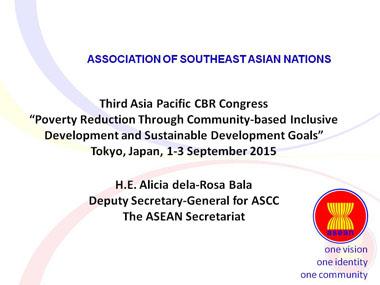 (Slide 1 text)
(Slide 1 text)
Slide 2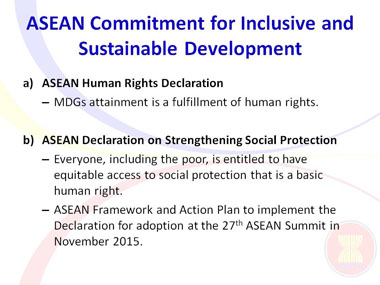 (Slide 2 text)
(Slide 2 text)
Slide 3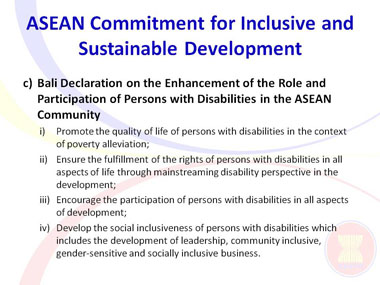 (Slide 3 text)
(Slide 3 text)
Slide 4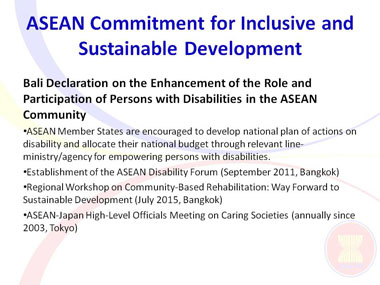 (Slide 4 text)
(Slide 4 text)
Slide 5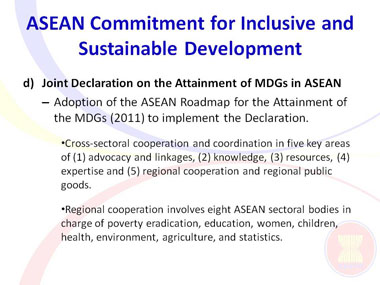 (Slide 5 text)
(Slide 5 text)
Slide 6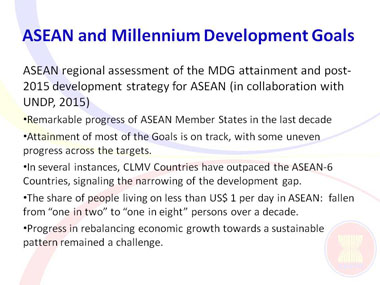 (Slide 6 text)
(Slide 6 text)
Slide 7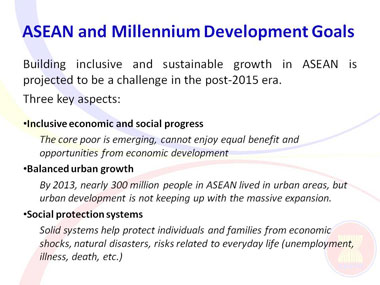 (Slide 7 text)
(Slide 7 text)
Slide 8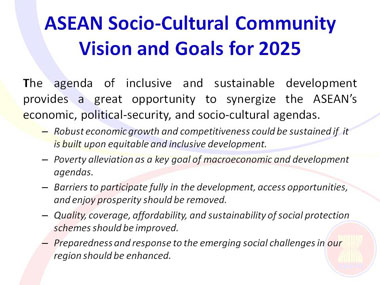 (Slide 8 text)
(Slide 8 text)
Slide 9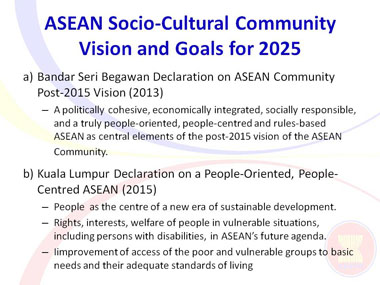 (Slide 9 text)
(Slide 9 text)
Slide 10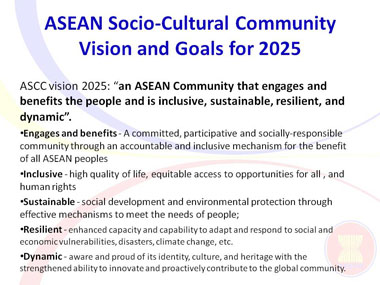 (Slide 10 text)
(Slide 10 text)
Slide 11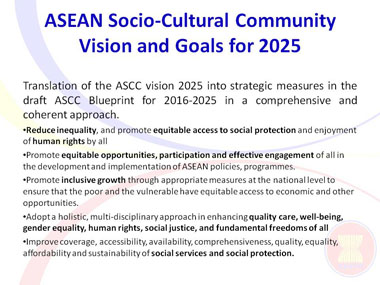 (Slide 11 text)
(Slide 11 text)
Slide 12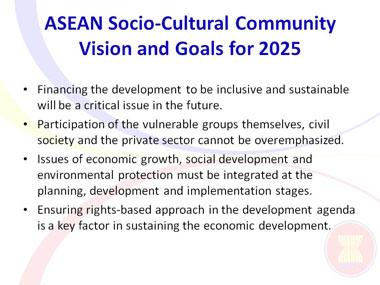 (Slide 12 text)
(Slide 12 text)
Slide 13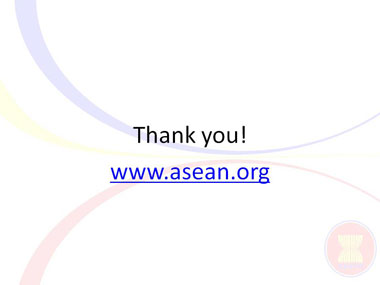 (Slide 13 text)
(Slide 13 text)
